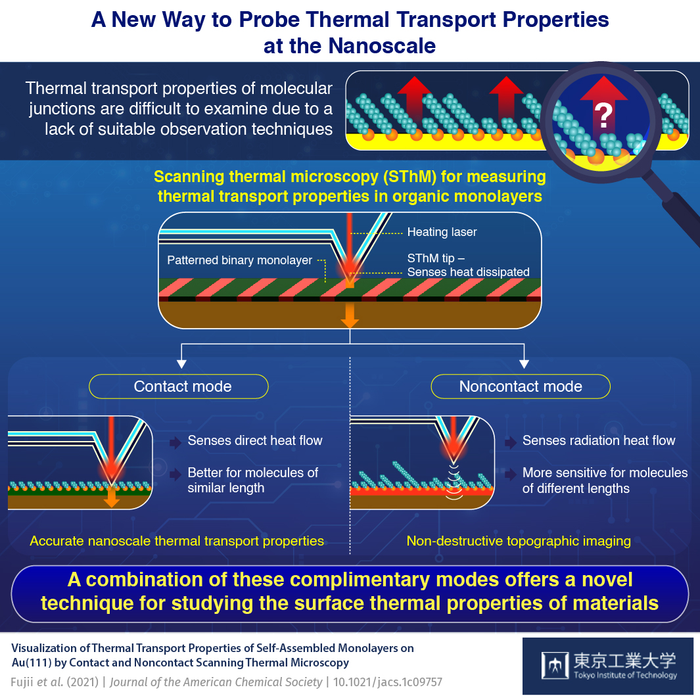Devices have been shrinking by the day, and new difficulties in their measurement and design present themselves. The electric transport properties of devices based on molecular junctions, where single molecules are bound to semiconductors or metals, can be analyzed and characterized using different techniques.

Image Credit: Tokyo Institute of Technology
On the other hand, investigating the thermal transport properties of such junctions at the nanoscale has been more difficult, and several temperature-related quantum phenomena in them are not understood so well.
In some studies, researchers managed to quantify the thermal transport properties in molecular junctions at the nanoscale with the help of a method known as scanning thermal microscopy (SThM). In this technique, a very sharp metallic tip is placed in contact with the target material and the tip is moved across the material’s surface.
The tip is heated from behind through a laser and consists of a thermocouple. This small device quantifies temperature variations and thus, by balancing the heating of the tip resulting from the laser with the tip’s cooling through heat flowing into the target sample, it is viable to quantify a material’s thermal transport characteristics point by point.
In a new study reported in the Journal of the American Chemical Society, researchers from Tokyo Tech described a serendipitous yet crucial finding while making use of SThM. The researchers were applying an SThM method to quantify the thermal transport properties of self-assembled monolayers (SAMs).
Such samples consisted of alternating stripes of each of the three possible pairs between n-Benzenethiol, n-Butanethiol and Hexadecanethiol. In addition to applying the standard contact-based SThM method, the scientists tried using a non-contact regime as well, in which the tip of the scanning thermal microscope was placed above the sample without touching it. Suddenly, the researchers realized this non-contact regime had some serious ability.
In the contact SThM regime, heat flows directly from the tip to the sample. On the other hand, in the non-contact SThM regime, the only heat transfer between the tip and the sample takes place through heat radiation.
Through experiments, the team discovered that although the contact regime is best for imaging the thermal transport characteristics, the non-contact regime is highly sensitive to the real length of the molecules “sticking out” from the substrate. Thus, the combination of the non-contact and contact regimes offers an all-new way of making topographic and thermal transport images of a sample concurrently.
Furthermore, the non-contact method has benefits over other well-established microscopy methods.
The non-contact SThM approach is completely non-destructive, unlike other techniques like atomic force microscopy, which does require contact between the scanning tip and the sample and thus has a mechanical impact that can damage soft organic materials.
Shintaro Fujii, Study Lead Author and Associate Professor, Tokyo Institute of Technology
On the whole, the understanding offered by this study will set the stage for novel technological progress and a deeper comprehension of materials at the nanoscale.
Our work not only is the first to provide thermal images of organic SAMs, but also provides a new technique for investigating thermal transport properties, which will be essential for thermal management in various types of nanodevices,
Shintaro Fujii, Study Lead Author and Associate Professor, Tokyo Institute of Technology
This study could help researchers explain several mysteries behind thermal phenomena.
Journal Reference:
Fujji, S., et al. (2021) Visualization of Thermal Transport Properties of Self-Assembled Monolayers on Au (111) by Contact and Noncontact Scanning Thermal Microscopy. Journal of American Chemical Society. doi.org/10.1021/jacs.1c09757.